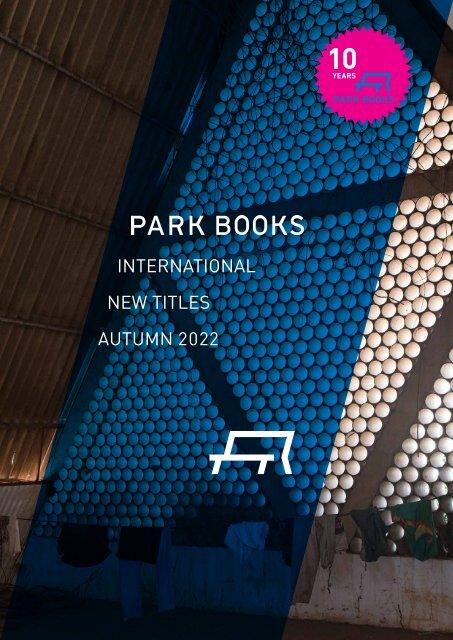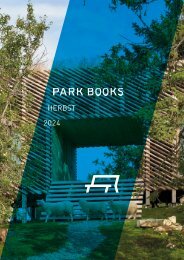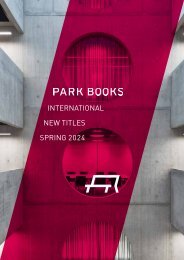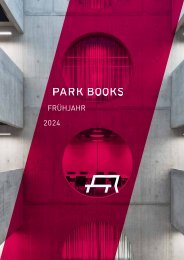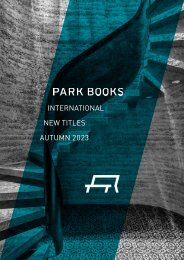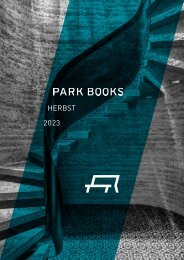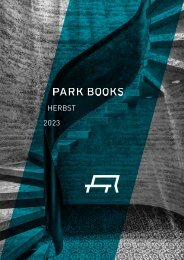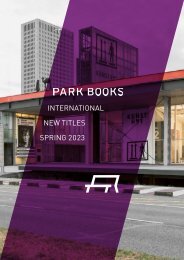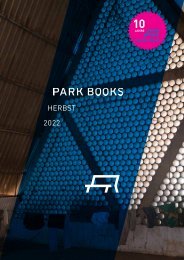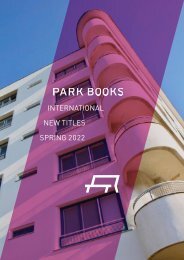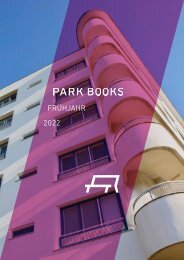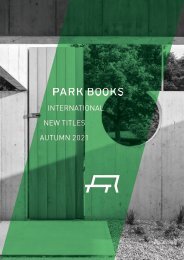Park Books International New Titles Autumn 2022
You also want an ePaper? Increase the reach of your titles
YUMPU automatically turns print PDFs into web optimized ePapers that Google loves.
INTERNATIONAL<br />
NEW TITLES<br />
AUTUMN <strong>2022</strong>
CONTENT<br />
4/5<br />
Medine Altiok, Mathias Müller, Daniel<br />
Niggli, Caspar Schärer (eds.)<br />
EM2N—City Factory<br />
Advocating for a City of Tolerant Co-Existence<br />
8/9<br />
Manuel Herz with Ingrid Schröder, Hans<br />
Focketyn, Julia Jamrozik (eds.)<br />
African Modernism<br />
The Architecture of Independence. Ghana,<br />
Senegal, Côte d’Ivoire, Kenya, Zambia<br />
12/13<br />
Gérald Ledent, Cécile Vandernoot (eds.)<br />
Institutions and the City<br />
The Role of Architecture<br />
16/17<br />
Labics, Maria Claudia Clemente,<br />
Francesco Isidori (eds.)<br />
Architecture of Public Space<br />
6/7<br />
François Charbonnet, Patrick Heiz<br />
Portraits<br />
Architectural Parables<br />
10/11<br />
Dick van Gameren<br />
Dutch Dwellings<br />
The Architecture of Housing<br />
14/15<br />
Institute of Constructive Design; ZHAW<br />
School of Architecture, Design and Civil<br />
Engineering; Eva Stricker, Guido Brandi,<br />
Andreas Sonderegger; Baubüro in situ<br />
AG; Zirkular GmbH; Marc Angst, Barbara<br />
Buser, Michel Massmünster (eds.)<br />
Re-Use in Construction<br />
A Compendium of Circular Architecture<br />
18/19<br />
Jörg Springer, Manuel Aust (eds.)<br />
The Synagogue Project<br />
On the Reconstruction of Synagogues in<br />
Germany<br />
<strong>Park</strong> <strong>Books</strong><br />
Niederdorfstrasse 54<br />
8001 Zurich, Switzerland<br />
Tel. +41 442621662<br />
www.park-books.com<br />
Publisher<br />
Thomas Kramer<br />
Tel. +41 442536454<br />
publisher@park-books.com<br />
Sales<br />
Patrick Schneebeli<br />
Tel. +41 442536453<br />
sales@park-books.com<br />
Publicity<br />
Domenica Schulz<br />
Tel. +41 442536452<br />
publicity@park-books.com
20/21<br />
Pichler & Traupmann Architekten (eds.)<br />
Pichler & Traupmann<br />
Architekten<br />
Tension in Space<br />
24/25<br />
Jesús Vassallo, Sebastián López Cardozo<br />
(eds.)<br />
Nueva Vivienda<br />
<strong>New</strong> Housing Paradigms in Mexico<br />
28/29<br />
Géraldine Borio<br />
Looking for the Voids<br />
Learning from Asia’s Liminal Urban Spaces as a<br />
Foundation to Expand an Architectural Practice<br />
32/33<br />
Matthias Armengaud, Aglaée Degros<br />
(eds.)<br />
Towards Territorial Transition<br />
A plea to large-scale decarbonizing<br />
36/37<br />
Onsitestudio, Giancarlo Floridi, Angelo<br />
Lunati (eds.)<br />
Corner kick<br />
Mapei football centre<br />
22/23<br />
Focketyn del Rio Studio, Claudia Mion<br />
(eds.)<br />
All Under One Roof<br />
Revolutionising Basel’s Military Barracks<br />
26/27<br />
James Glisson, Marshall Brown (eds.)<br />
The Architecture of Collage<br />
Marshall Brown<br />
30/31<br />
Holly Baker, Pablo Garrido, Ainsley<br />
Johnston, Amy Perkins, Rubén Valdez,<br />
Francisco Moura Veiga (eds.)<br />
CARTHA—Building Identity<br />
A Handbook for Architectural Design<br />
34/35<br />
Iris Kaltenegger, Bart Lootsma,<br />
EUROPAN Austria (eds.)<br />
EUROPAN 16 Austria—<br />
Living Cities<br />
38/39<br />
Recent Releases<br />
and Key <strong>Titles</strong><br />
1 2/3<br />
4 5 6 7 8 9 10 11 12 13 14 15 16 17 18 19 20 21 22 23 24 25 26 27 28 29 30 31 32 33 34 35 36 37 38 39 40
How do our cities evolve, what forces drive their evolution, and<br />
how exactly do they change as a result? Zurich-based architecture<br />
firm EM2N has been working on urban transformation processes<br />
ever since its establishment in 1997. Initially, the firm’s<br />
main focus was on the greater Zurich area, yet in recent years<br />
they have also developed and realized projects in Berlin, Brussels,<br />
and Hamburg. Over time, a diverse body of work has grown,<br />
more than half of which consists of conversions of existing buildings,<br />
resulting in numerous successes and a few failures, small<br />
structures and large-scale complexes, quick decisions and slow<br />
processes. What unites the designs, projects, and texts featured<br />
in this first monograph on EM2N is a profound interest in the<br />
concept of the city as an exciting, contradictory, and above all<br />
productive space of human life that the founding partners Mathias<br />
Müller and Daniel Niggli have maintained throughout their<br />
twenty-five years of collaboration.<br />
Zurich-based architects EM2N<br />
have been actively contributing<br />
to Zurich’s urban transformation<br />
for twenty-five years—this<br />
is their first major monograph<br />
In EM2N—City Factory they offer a self-critical review of their<br />
achievements and also speak about learning processes, personal<br />
interests, and conceptual approaches to future tasks in<br />
ever-changing cities. This is supplemented with contributions<br />
from fellow architects and friends as well as with a wealth of<br />
photographs, plans, drawings, and other illustrations.<br />
Medine Altiok is an architect who runs her own<br />
practice with offices in Zurich and Aachen. She<br />
is a lecturer at various universities and schools,<br />
such as ETH Zurich, BILGI University Istanbul,<br />
and the AA School of Architecture in London.<br />
Mathias Müller and Daniel Niggli established<br />
their firm EM2N in Zurich in 1997, which nowadays<br />
also includes offices in Berlin and Brussels.<br />
They have taught as visiting professors at<br />
EPFL in Lausanne and ETH Zurich.<br />
Caspar Schärer is a Zurich-based architect,<br />
publicist, and architecture critic.<br />
EN<br />
ISBN 978-3-03860-086-2<br />
GE<br />
ISBN 978-3-03860-085-5
First monograph on Zurich-based architecture<br />
firm EM2N<br />
Documents EM2N’s achievements of twenty-five<br />
years through texts and a wealth of photographs,<br />
plans, drawings, and visualizations,<br />
most of them published in this book for the first<br />
time<br />
Highlights EM2N’s profound engagement with<br />
the city as an evolving and productive space of<br />
human life<br />
EM2N enjoy wide international recognition for<br />
their building and urban designs, their conversions<br />
of existing buildings, as well as for their<br />
contributions to architectural discourse<br />
Medine Altiok, Mathias Müller, Daniel<br />
Niggli, Caspar Schärer (eds.)<br />
EM2N—City Factory<br />
Advocating for a City of Tolerant Co-Existence<br />
Contributions by Mathias Müller and Daniel<br />
Niggli, Marc Angélil, Max Küng, Marcel Meili,<br />
and Peter Swinnen. Photographs by Filip<br />
Dujardin, Roland Fässler, Roger Frei, Simon<br />
Menges, Damian Poffet, and Joël Tettamanti.<br />
Illustrations by Ingo Giezendanner<br />
Book design by Bonbon<br />
Paperback<br />
approx. 488 pages, 600 color and 150 b/w<br />
illustrations<br />
21.5 × 31.5 cm<br />
978-3-03860-086-2 English<br />
978-3-03860-085-5 German<br />
sFr. 75.00 | € 68.00 | £ 60.00 | $ 85.00<br />
October <strong>2022</strong> (Europe) | February 2023 (US)<br />
1 2 3 4/5<br />
6 7 8 9 10 11 12 13 14 15 16 17 18 19 20 21 22 23 24 25 26 27 28 29 30 31 32 33 34 35 36 37 38 39 40
It may sound banal, yet it is a fundamental truth of architectural<br />
design: all ideas are based on previous ideas, on their imitation,<br />
inversion, rejection, or adaptation; or on their reinterpretation or<br />
ignoration. The same applies to our visual perception and how it<br />
influences our thinking and world of ideas. It is actually true for<br />
any kind of creation and design.<br />
Made In, one of Switzerland’s most<br />
exciting architectural firms, presents<br />
the quintessence of their thinking:<br />
an original and thought-provoking<br />
challenge to ideas about art,<br />
perception, and architectural design.<br />
Portraits: Architectural Parables traces these questions through<br />
a wealth of images from art history and everyday culture, as<br />
well as through analytical and classifying texts. With this book,<br />
François Charbonnet and Patrick Heiz, the founding partners<br />
of the highly acclaimed Swiss design firm Made In, reveal the<br />
approaches they take in their design methodology as well as in<br />
their teaching at ETH Zurich’s Department of Architecture and<br />
Accademia di architettura in Mendrisio. The distinctive feature<br />
lies in the linking and collaging of mutually illuminating, yet<br />
apparently antagonistic, programs. Made In’s method does not<br />
claim historical accuracy, as sources and facts are intentionally<br />
collaged to serve a reductive purpose. The focus is on the potential<br />
they see in the cross-fertilization of different images and<br />
ideas rather than on a single, all-embracing model of thought.<br />
François Charbonnet and Patrick Heiz are the<br />
founding partners of Geneva- and Zurich-based<br />
design firm Made In. They have gained wide<br />
recognition for a range of private commissions<br />
and submissions to public competitions. They<br />
jointly teach as full Professors of Architecture<br />
and Design at ETH Zurich’s Department of Architecture<br />
and also lecture at various international<br />
universities and institutions.<br />
ISBN 978-3-03860-309-2
The first book by the highly acclaimed Swiss<br />
architecture firm Made In<br />
Introduces the methodology underlying the<br />
design and teaching practice of Made In’s<br />
founding partners François Charbonnet and<br />
Patrick Heiz<br />
Introduces Made In’s thinking that is based<br />
on the analysis and linking of images and the<br />
concepts they convey<br />
Illustrates how existing ideas and visual<br />
perceptions can set our minds in motion and<br />
generate new ideas and designs<br />
François Charbonnet, Patrick Heiz<br />
Portraits<br />
Architectural Parables<br />
Book design by Atlas Studio<br />
Hardback<br />
approx. 640 pages, 400 color and<br />
300 b/w illustrations<br />
18 × 30 cm<br />
978-3-03860-309-2 English<br />
sFr. 99.00 | € 97.00 | £ 85.00 | $ 110.00<br />
October <strong>2022</strong> (Europe) | February 2023 (US)<br />
1 2 3 4 5 6/7<br />
8 9 10 11 12 13 14 15 16 17 18 19 20 21 22 23 24 25 26 27 28 29 30 31 32 33 34 35 36 37 38 39 40
Marking <strong>Park</strong> <strong>Books</strong>’ 10th anniversary:<br />
a new edition of this unique and widely<br />
acclaimed survey of Africa’s modernist<br />
architecture<br />
“You really have to get Mr. Herz’s book<br />
African Modernism, a 640-page doorstop<br />
published when this show first<br />
appeared in Germany, to appreciate<br />
the breadth of modern African architecture,<br />
as well as its political significance<br />
and contemporary afterlives.”<br />
Jason Farago, The <strong>New</strong> York Times<br />
When African Modernism was first published in 2015, it was<br />
showered with international praise and has been sought after<br />
ever since it went out of print in 2018. Marking <strong>Park</strong> <strong>Books</strong>’ 10th<br />
anniversary, this landmark book will now be available again.<br />
Over the course of the 1950s and 1960s, most African countries<br />
gained independence from their respective colonial powers.<br />
Architecture became one of the principal means by which the<br />
newly formed states expressed their national identity. African<br />
Modernism investigates the close relationship between architecture<br />
and nation-building in Ghana, Senegal, Côte d’Ivoire, Kenya,<br />
and Zambia. It features 100 buildings with brief descriptive texts,<br />
images, site plans, selected floor plans and sections. The vast<br />
majority of images were taken by Iwan Baan and Alexia Webster<br />
especially for the book’s first edition, documenting the buildings<br />
in their present state. Each country is portrayed through<br />
an introductory text and a timeline of historic events. Additional<br />
essays on specific aspects and topics of postcolonial Africa, likewise<br />
richly illustrated with images and documents, round out<br />
this outstanding volume.<br />
“The care that Herz and his fellow editors,<br />
Ingrid Schröder, Hans Focketyn,<br />
and Julia Jamrozi, have taken to<br />
provide a balanced and comprehensive<br />
discussion of the origins of modernism<br />
in Africa will make this a seminal work<br />
in the discourse of African architecture.<br />
No book collection on African architecture<br />
would be complete without it.”<br />
Sir David Adjaye RA, Architectural<br />
Record<br />
Manuel Herz runs his own design and urban<br />
planning studio in Basel and Cologne. He is<br />
assistant professor at the University of Basel.<br />
Ingrid Schröder is an architect and director of<br />
the MPhil program in Architecture and Urban<br />
Design at the University of Cambridge. She<br />
was appointed director of the Architectural<br />
Association’s School of Architecture in London<br />
in May <strong>2022</strong> and will assume that position in<br />
August <strong>2022</strong>.<br />
Hans Focketyn runs his own architecture firm<br />
in Basel and teaches as a professor at Bern<br />
University of Applied Sciences’ School of Architecture,<br />
Wood and Civil Engineering in Burgdorf,<br />
Switzerland.<br />
Julia Jamrozik is an architect and assistant<br />
professor at the University of Buffalo’s School of<br />
Architecture in Buffalo, NY.<br />
ISBN 978-3-03860-294-1
<strong>New</strong> edition of the most comprehensive survey<br />
of modernist architecture in Africa to date<br />
An unrivaled study of the close relationship<br />
between architecture and nation-building in<br />
African countries after gaining independence<br />
from their colonial powers<br />
Features detailed descriptions of more than 100<br />
buildings and memorials in Ghana, Senegal,<br />
Côte d’Ivoire, Kenya, Zambia<br />
Lavishly illustrated with photographs by distinguished<br />
artists Iwan Baan and Alexia Webster,<br />
as well as with historic images and plans<br />
Manuel Herz with Ingrid Schröder, Hans<br />
Focketyn, Julia Jamrozik (eds.)<br />
African Modernism<br />
The Architecture of Independence. Ghana,<br />
Senegal, Côte d’Ivoire, Kenya, Zambia<br />
Photographs by Iwan Baan and Alexia Webster<br />
Book design by Studio Marie Lusa<br />
Paperback<br />
640 pages, 909 color and 300 b/w illustrations<br />
23.5 × 32 cm<br />
978-3-03860-294-1 English<br />
sFr. 99.00 | € 85.00 | £ 75.00 | $ 99.00<br />
October <strong>2022</strong> (Europe) | December <strong>2022</strong> (US)<br />
1 2 3 4 5 6 7 8/9<br />
10 11 12 13 14 15 16 17 18 19 20 21 22 23 24 25 26 27 28 29 30 31 32 33 34 35 36 37 38 39 40
Dick van Gameren, a partner with the renowned Dutch architecture<br />
firm Mecanoo, has engaged in housing design for the past<br />
twenty-five years through his work as an architect as well as in<br />
his research and teaching at TU Delft’s Global Housing Study<br />
Center. In this book, he presents around forty of his own projects<br />
in this field, through concise texts and photographs with explanatory<br />
captions as well as plans and drawings. The projects are<br />
grouped to illustrate seven specific aspects of housing design:<br />
Streets and Squares, Courtyards and Patios, Gardens, Halls, the<br />
Fireplace, Walls, and Roofs. Together, they constitute a multifaceted<br />
catalog of housing typologies.<br />
In four supplementary essays, van Gameren explores evolutions<br />
in residential architecture in the Netherlands. He positions his<br />
own concepts in the context of these developments and expands<br />
on what he considers the key factors of good housing design. He<br />
places particular focus on affordable housing, a pressing issue<br />
in so many countries and metropolitan areas around the world.<br />
Dutch Dwellings is an inspiring read for anyone involved in housing<br />
design today.<br />
History and present of pioneering<br />
housing design in the Netherlands<br />
Dick van Gameren is an architect and partner<br />
with the internationally acclaimed Delft-based<br />
firm Mecanoo. He is also a Professor of Dwelling<br />
at TU Delft’s Department of Architecture<br />
and the Built Environment, where he currently<br />
serves as Dean. He has won many prizes for his<br />
work, such as the 2007 Aga Khan Award and the<br />
2012 BNA Building of the Year Award.<br />
ISBN 978-3-03860-304-7
Housing design is one of the core building<br />
tasks and arguably the most important topic in<br />
architecture today<br />
Housing design in the Netherlands has<br />
produced distinct new typologies with<br />
characteristic qualities<br />
Dick van Gameren’s book features the findings<br />
of twenty-five years of design practice and<br />
research<br />
Documents some forty of van Gameren’s<br />
designs through images, plans, and<br />
illuminating texts<br />
Dick van Gameren is a partner with the widely<br />
acclaimed Dutch firm Mecanoo<br />
Dick van Gameren<br />
Dutch Dwellings<br />
The Architecture of Housing<br />
Book design by Sandra Doeller<br />
Hardback<br />
approx. 304 pages, 450 color and<br />
250 b/w illustrations and plans<br />
21 × 27.5 cm<br />
978-3-03860-304-7 English<br />
sFr. 65.00 | € 58.00 | £ 50.00 | $ 70.00<br />
November <strong>2022</strong> (Europe) | March 2023 (US)<br />
1 2 3 4 5 6 7 8 9 10/11<br />
12 13 14 15 16 17 18 19 20 21 22 23 24 25 26 27 28 29 30 31 32 33 34 35 36 37 38 39 40
Institutions such as the state, church, army, judiciary, bank, university—or<br />
even marriage—organize our social relations. As<br />
inherently social structures, they regulate societies according<br />
to various practices, rites, and rules of conduct, and guide our<br />
actions by delimiting what is possible and thinkable. An institution’s<br />
individual scope depends on society’s understanding of it.<br />
They are in perpetual mutation and thus form complex entities.<br />
Architecture plays an essential role in the establishment, identification,<br />
and perpetuation of this social structure as it formalizes<br />
value systems in space and represents ideologies in permanent<br />
physical structures.<br />
Institutions & the City investigates how architecture establishes<br />
and reveals the way an institution functions through different<br />
strategies, taking the Tracé Royal (the royal route) in Brussels<br />
as an example of an urban figure. This succession of emblematic<br />
streets, extending from the Palace of Justice in the heart<br />
of the city to the Church of Our Lady and the Royal Domain in<br />
Laeken, is home to several of Belgium’s national political, legal,<br />
religious, financial, and cultural institutions. The book explores<br />
the strategies applied over time by the various institutions to<br />
leave a lasting inscription on the country’s social order, revealing<br />
similar spatial responses and surprisingly prevalent mutation<br />
processes. And it highlights the importance of architecture in<br />
inventing new relationships with institutional spaces in order to<br />
improve the way we live together in a time when social, political,<br />
and cultural reference points are being blurred.<br />
What role does architecture play in<br />
establishing and maintaining public<br />
institutions that shape both society<br />
as a whole and our individual lives?<br />
Gérald Ledent is a cofounder of Brussels-based<br />
architecture firm KIS studio and professor at<br />
the Faculty of Architecture, Architectural Engineering,<br />
and Urban Planning (LOCI), Catholic<br />
University of Louvain (UCLouvain).<br />
Cécile Vandernoot is an architect and architectural<br />
critic. She is pursuing her PhD and teaches<br />
at the Faculty of Architecture, Architectural Engineering,<br />
and Urban Planning (LOCI), Catholic<br />
University of Louvain (UCLouvain).<br />
ISBN 978-3-03860-293-4
A groundbreaking study of architecture’s role<br />
in the establishment, identification, and perpetuation<br />
of public institutions that shape and<br />
structure societies and the life of individuals<br />
Presents the results of a three-year research<br />
project at the Faculty of Architecture, Architectural<br />
Engineering, and Urban Planning (LOCI) at<br />
UCLouvain<br />
Features essays by leading scholars that are<br />
organized around architectural drawings and<br />
collages produced by LOCI students, as well<br />
as previously unpublished archival documents,<br />
maps, and engravings<br />
Gérald Ledent, Cécile Vandernoot (eds.)<br />
Institutions and the City<br />
The Role of Architecture<br />
Contributions by Delphine Dulong, Dietmar<br />
Eberle, Christian Gilot, Gérald Ledent, Sophia<br />
Psarra, and Cécile Vandernoot<br />
Book design by NN – Jurgen Persijn<br />
Paperback<br />
272 pages, 122 color and 169 b/w illustrations<br />
17 × 24 cm<br />
978-3-03860-293-4 English / French / Dutch<br />
sFr. 39.00 | € 38.00 | £ 32.00 | $ 45.00<br />
October <strong>2022</strong> (Europe) | December <strong>2022</strong> (US)<br />
1 2 3 4 5 6 7 8 9 10 11 12/13<br />
14 15 16 17 18 19 20 21 22 23 24 25 26 27 28 29 30 31 32 33 34 35 36 37 38 39 40
Re-using entire parts and components of existing buildings in<br />
the construction of new structures has become highly topical in<br />
European architecture discourse. Re-using elements that could<br />
last for decades longer, rather than destroying them, offers huge<br />
potential in saving increasingly scarce resources. Moreover, it<br />
makes construction more climate-friendly through deep cuts<br />
in energy consumption and the emission of greenhouse gases.<br />
For millennia, disused buildings have been cannibalized for the<br />
construction of new ones. Yet, in today’s world, what is known as<br />
circular architecture raises a multitude of questions and challenges<br />
with regard to technology, safety, energy, and associated<br />
legal aspects.<br />
This book is a unique compendium of circular architecture. Richly<br />
illustrated, it explores comprehensively through essays and<br />
illuminating conversations between experts all the questions<br />
and challenges that architects and engineers face with circular<br />
architecture designs. It is based on the case study of the K.118<br />
project in Winterthur, Switzerland’s largest building to date that<br />
consists mainly of re-used parts. Since its outset in 2018, the<br />
K.118 project has been evaluated within the framework of an<br />
interdisciplinary research with regard to aspects of design and<br />
engineering, energy, economy, processes, and legal issues. This<br />
volume presents the results in striking visuals and concise texts.<br />
Circular architecture offers huge<br />
potential in saving increasingly<br />
scarce resources and avoiding<br />
harmful greenhouse gas emissions,<br />
and leads to a more sustainable and<br />
energy-saving construction process<br />
The Institute of Constructive Design, based in<br />
Winterthur as part of ZHAW School of Architecture,<br />
Design and Civil Engineering, is an interactive<br />
hub for teaching and research in building<br />
design and construction.<br />
Eva Stricker is a Zurich-based architect and<br />
writer, who also works as a researcher at the<br />
Institute of Constructive Design, ZHAW School<br />
of Architecture, Design and Civil Engineering.<br />
Guido Brandi is cofounder of Zurich- and Comobased<br />
architecture firm brandiguerra and a researcher<br />
at the Institute of Constructive Design,<br />
ZHAW School of Architecture, Design and Civil<br />
Engineering.<br />
Andreas Sonderegger is a founding partner with<br />
pool Architekten in Zurich and codirector of the<br />
Institute of Constructive Design, ZHAW School<br />
of Architecture, Design and Civil Engineering.<br />
Baubüro in situ AG and its affiliate Zirkular<br />
GmbH, with offices in Basel and Zurich, are<br />
leading Swiss design and planning firms specializing<br />
in circular and sustainable architecture<br />
and construction processes.<br />
Marc Angst is an urban designer working as a<br />
re-use expert with Baubüro in situ and Zirkular<br />
GmbH in Zurich and Basel.<br />
Barbara Buser is an architect and cofounder of<br />
Baubüro in situ in Basel and Zurich. She also<br />
teaches as a visiting lecturer at ETH Zürich’s<br />
Department of Architecture.<br />
Michel Massmünster is a Basel-based cultural<br />
anthropologist working at the interface of<br />
urban research, journalism, and sociocultural<br />
mediation.<br />
EN<br />
ISBN 978-3-03860-295-8<br />
GE<br />
ISBN 978-3-03860-259-0
A unique compendium of circular architecture<br />
today<br />
A rich and inspirational source for architects<br />
and engineers and their clients<br />
Answers questions with regard to design and<br />
engineering, energy, economy, processes, and<br />
legal issues of circular architecture projects<br />
Lavishly illustrated with photos and plans, as<br />
well as informative diagrams and graphs<br />
Institute of Constructive Design; ZHAW<br />
School of Architecture, Design and Civil<br />
Engineering; Eva Stricker, Guido Brandi,<br />
Andreas Sonderegger; Baubüro in situ<br />
AG; Zirkular GmbH; Marc Angst, Barbara<br />
Buser, Michel Massmünster (eds.)<br />
Re-Use in Construction<br />
A Compendium of Circular Architecture<br />
Book design by Ludovic Balland Typography<br />
Cabinet, Ludovic Balland and Annina Schepping<br />
Hardback<br />
approx. 344 pages, 401 color and<br />
54 b/w illustrations<br />
21.5 × 28.5 cm<br />
978-3-03860-295-8 English<br />
978-3-03860-259-0 German<br />
sFr. 65.00 | € 58.00 | £ 50.00 | $ 75.00<br />
October <strong>2022</strong> (Europe) | March 2023 (US)<br />
1 2 3 4 5 6 7 8 9 10 11 12 13 14/15<br />
16 17 18 19 20 21 22 23 24 25 26 27 28 29 30 31 32 33 34 35 36 37 38 39 40
This new book by Labics, one of Italy’s leading architectural<br />
firms, is devoted to the country’s architecture of public space.<br />
Squares, galleries, loggias, porticoes, and courtyards, are the<br />
elements that characterize Italy’s historic towns and cities—and<br />
that make these places so endlessly attractive to visitors. Yet<br />
the volume does not feature new designs by Labics themselves:<br />
rather, Maria Claudia Clemente, Francesco Isidori, and their collaborators<br />
set out to explore these enchanting spaces, to analyze<br />
their history and typologies, and to document and describe them<br />
through newly taken as well as historic photographs, plans, and<br />
diagrams.<br />
The Architecture of Public Space forms a captivating collection<br />
of visually explained characteristics of these core elements of<br />
Italian cities. It highlights the architectural solutions from the<br />
thirteenth to the twentieth centuries behind the particular spatial<br />
quality of these urban structures, and sets out how they are<br />
being established for and used by the people.<br />
A captivating visual description of<br />
the famous public spaces that make<br />
Italy’s historic towns and cities so<br />
timelessly attractive<br />
Also available:<br />
Labics—Structures<br />
978-3-03860-128-9<br />
English<br />
sFr. 65.00 | € 58.00<br />
£ 50.00 | $ 69.00<br />
ISBN 978-3-03860-128-9<br />
Maria Claudia Clemente and Francesco Isidori are<br />
the founding partners of Rome-based architecture<br />
firm Labics. They also lecture and serve as<br />
guest critics at international universities, such<br />
as Cornell University’s School of Architecture in<br />
Ithaca, NY, and Rome.<br />
9 783038 601289<br />
ISBN 978-3-03860-311-5
Rome-based Labics is one of Italy’s leading<br />
architecture firms that has earned much<br />
international recognition for both its designs<br />
and research work<br />
The book features the result of Labic’s<br />
extensive research into the public spaces of<br />
Italy’s historic towns and cities<br />
Reveals what makes these famous urban<br />
spaces so timelessly attractive to visitors and<br />
locals alike<br />
Heavily illustrated with newly taken and<br />
historic photographs, plans, and drawings<br />
Labics, Maria Claudia Clemente,<br />
Francesco Isidori (eds.)<br />
Architecture of Public Space<br />
Book design by Sämi Bänziger<br />
Paperback<br />
approx. 480 pages, 250 color and<br />
200 b/w illustrations and plans<br />
23 × 31 cm<br />
978-3-03860-311-5 English<br />
sFr. 59.00 | € 58.00 | £ 52.00 | $ 65.00<br />
November <strong>2022</strong> (Europe) | March 2023 (US)<br />
1 2 3 4 5 6 7 8 9 10 11 12 13 14 15 16/17<br />
18 19 20 21 22 23 24 25 26 27 28 29 30 31 32 33 34 35 36 37 38 39 40
Germany is currently experiencing an intense debate about the<br />
reconstruction of synagogues that were destroyed under Nazi<br />
rule in the 1930s, and the related search for an appropriate architectural<br />
expression of Jewish life and culture in the country’s<br />
major cities today. This book, which results from a collaboration<br />
between the Technical Universities of Darmstadt and Dresden,<br />
Hamburg’s HafenCity University, and the Bauhaus-Universität<br />
Weimar, vividly contributes to this discussion.<br />
A significant contribution to the<br />
debate on the reconstruction of<br />
German synagogues destroyed under<br />
Nazi rule in the 1930s<br />
The Synagogue Project features designs for new synagogues<br />
replacing the lost buildings on Berlin’s Fraenkelufer and on<br />
Joseph-Carlebach-Platz and Poolstrasse in Hamburg by students<br />
at the participating universities. They illustrate the search<br />
for a structural expression that can provide space for Jewish life<br />
and worship in the future. In conversation, members of Jewish<br />
communities and Franz-Josef Höing, representing the City of<br />
Hamburg’s department of urban development and housing, explain<br />
their views on the past and future of synagogues in Hamburg<br />
and Berlin. Mirjam Wenzel, director of the Jewish Museum<br />
in Frankfurt, Salomon Korn, former vice-president of Germany’s<br />
Central Council of Jews, Rabbi Edward van Voolen, and Swiss<br />
architect Roger Diener also contribute to the discussion on the<br />
history and significance of spaces for Jewish life, culture, and<br />
religion in German cities.<br />
Jörg Springer is principal of the Berlin-based<br />
firm Springer Architekten. He is also a professor<br />
of design and complex building theory at<br />
Bauhaus-Universität Weimar.<br />
Manuel Aust is an architect and research associate<br />
at the chair of design and complex building<br />
theory, Bauhaus-Universität Weimar.<br />
ISBN 978-3-03860-300-9
The reconstruction of German synagogues<br />
destroyed under Nazi rule in the 1930s is the<br />
subject of intense public debate<br />
The book features designs for new synagogue<br />
buildings in Berlin and Hamburg by students<br />
from four German universities<br />
Conversations with representatives of Jewish<br />
communities, organizations, and institutions,<br />
Hamburg’s city government, a rabbi, and an<br />
architect explore key aspects of the history and<br />
future of Jewish life and religious architecture<br />
in Germany<br />
Jörg Springer, Manuel Aust (eds.)<br />
The Synagogue Project<br />
On the Reconstruction of Synagogues in<br />
Germany<br />
Conversations between Wolfgang Lorch, Ivan<br />
Reimann, Jörg Springer, and Gesine Weinmiller<br />
with Roger Diener, Franz-Josef Höing, Salomon<br />
Korn, Mario Marcus, Dekel Peretz, Philipp<br />
Stricharz, Edward van Voolen, and Mirjam<br />
Wenzel<br />
Book design by Bucharchitektur \ Kathrin<br />
Schmuck<br />
Hardback<br />
approx. 232 pages, 350 color and<br />
30 b/w illustrations<br />
23.5 × 29.5 cm<br />
978-3-03860-300-9 English / German<br />
sFr. 39.00 | € 38.00 | £ 35.00 | $ 45.00<br />
August <strong>2022</strong> (Europe) | February 2023 (US)<br />
1 2 3 4 5 6 7 8 9 10 11 12 13 14 15 16 17 18/19<br />
20 21 22 23 24 25 26 27 28 29 30 31 32 33 34 35 36 37 38 39 40
On the occasion of their thirtieth anniversary, Vienna-based<br />
Pichler & Traupmann Architekten review their body of work to<br />
date. This lavishly illustrated monograph documents in great<br />
detail their most important designs, built and unrealized, arranged<br />
by topic. <strong>International</strong>ly renowned architectural publicists<br />
and scientists contribute essays that explore the firm’s<br />
vision and approach. A complete index of their 250 or so projects<br />
and studies rounds out the book.<br />
At the core of Pichler & Traupmann Architekten’s ambitious<br />
design philosophy is the potential of a given site in the field<br />
of tension between polarities. The focus of their work is on<br />
commercial, residential, and educational structure. Their key<br />
designs include the headquarters of the Austrian motorists’ association<br />
ÖAMTC in Vienna (2013–16), the extension of the Kulturzentrum<br />
Eisenstadt (2009–12), the Future Art Lab of Vienna’s<br />
University of Music and Performing Arts (2014–20), the RAIQA<br />
(Raiffeisen-Quartier) in Innsbruck (ongoing since 2019), and the<br />
Pinkafeld Campus of Burgenland University of Applied Sciences<br />
(ongoing since 2019).<br />
A multifaceted review of Vienna-based<br />
Pichler & Traupmann Architekten’s<br />
achievements of three decades<br />
Pichler & Traupmann Architekten was founded in<br />
1992 by Christoph Pichler and Johann Traupmann<br />
and has since completed a wide range of<br />
commissions of various typologies, for which<br />
the Vienna-based firm has been awarded numerous<br />
prizes. Christoph Pichler also lectures<br />
at the Technical Universities in Vienna and Graz,<br />
Johann Traupmann teaches as an assistant professor<br />
at Vienna’s University of Applied Arts.<br />
ISBN 978-3-03860-306-1
Pichler & Traupmann Architekten are one of<br />
Austria’s most distinguished contemporary<br />
architecture firms<br />
This is Pichler & Traupmann Architekten’s first<br />
comprehensive monograph, marking their<br />
thirtieth anniversary<br />
Richly illustrated with photos, visualizations,<br />
and plans, most of them previously unpublished<br />
Pichler & Traupmann Architekten (eds.)<br />
Pichler & Traupmann<br />
Architekten<br />
Tension in Space<br />
Contributions by Matthias Boeckl, Barbara<br />
Jahn-Rösel, Otto Kapfinger, Franziska Leeb,<br />
Christian Kühn, Elsa Prochazka, Stefan Rotter,<br />
Anna Soucek, William Tate, and Thomas<br />
Traupmann<br />
Book design by Bueronardin – visuelle Kommunikation<br />
Hardback<br />
approx. 264 pages, 450 color and<br />
50 b/w illustrations<br />
24 × 28 cm<br />
978-3-03860-306-1 English / German<br />
sFr. 49.00 | € 48.00 | £ 45.00 | $ 55.00<br />
October <strong>2022</strong> (Europe) | February 2023 (US)<br />
1 2 3 4 5 6 7 8 9 10 11 12 13 14 15 16 17 18 19 20/21<br />
22 23 24 25 26 27 28 29 30 31 32 33 34 35 36 37 38 39 40
In a complex transformation, the Basel-based architecture firm<br />
Focketyn del Rio Studio has converted the main building of the<br />
city’s former military barracks into a vibrant cultural and creative<br />
hub. Situated on the embankment of the Rhine, already a<br />
hotspot of Basel’s almost Mediterranean-style nightlife, it offers<br />
some 32,000 square feet of work and project spaces, a spacious<br />
plaza, a theater hall, as well as a bar and restaurant.<br />
The historic main building of the<br />
former military barracks in Basel<br />
has been turned into a new public,<br />
creative space on the city’s river<br />
front: Focketyn del Rio Studio on the<br />
collaborative process of a remarkable<br />
transformation<br />
This book documents the building’s new architecture in detail<br />
and tells the story of Focketyn del Rio Studio, which won the<br />
competition for rebuilding the Kaserne Basel in 2013 only six<br />
months after it was established. Interviews, concise texts, photographs,<br />
as well as plans and drawings, provide insight into the<br />
evolution of the project, the history of the old barracks, and the<br />
complex process of their transformation. It also features the<br />
perspectives of the various participants and stakeholders in the<br />
undertaking. All Under One Roof also takes the example of what<br />
has been inaugurated as kHaus in the spring of <strong>2022</strong> to discuss<br />
key questions of the design and use of urban public spaces, topics<br />
of great importance for urbanists, architects, and public decision-makers<br />
far beyond Basel.<br />
Basel-based Focketyn del Rio Studio, established<br />
in 2013 by Miquel del Rio and Hans Focketyn,<br />
has gained wide recognition for the reconstruction<br />
of Basel’s former military barracks and<br />
other urban design proposals and concepts of<br />
interim use of existing structures. In 2014, the<br />
firm won the Foundation Award for Young Swiss<br />
Architects.<br />
Claudia Mion is an architect and editorial director<br />
of Caryatide, a Paris-based platform for<br />
reflection on architecture, art, and design. She<br />
is also a visiting professor at the École Spéciale<br />
d’Architecture in Paris.<br />
ISBN 978-3-03860-256-9
Documents the complex transformation of<br />
Basel’s former military barracks into a<br />
cultural and creative hub by Focketyn del<br />
Rio Studio<br />
Discusses key issues of the design and use of<br />
public spaces in cities<br />
First book on the work of Focketyn del Rio<br />
Studio, which enjoys wide acclaim for its urban<br />
design proposals and concepts for interim<br />
uses of existing structures<br />
Focketyn del Rio Studio, Claudia Mion<br />
(eds.)<br />
All Under One Roof<br />
Revolutionising Basel’s Military Barracks<br />
Contributions by Beat Aeberhard, Katrin<br />
Groegel, Dorothea Huber, Guy Morin, Kevin<br />
M. Rahner, and Nina Zimmer. Photographs<br />
by Adrià Goula, laurian Ghinitoiu, and Maris<br />
Merzeulis<br />
Book design by Studio Storz<br />
Paperback<br />
approx. 208 pages, 160 color and<br />
60 b/w illustrations and plans<br />
22.5 × 33 cm<br />
978-3-03860-256-9 English / German<br />
sFr. 49.00 | € 48.00 | £ 45.00 | $ 55.00<br />
November <strong>2022</strong> (Europe) | April 2023 (US)<br />
1 2 3 4 5 6 7 8 9 10 11 12 13 14 15 16 17 18 19 20 21 22/23<br />
24 25 26 27 28 29 30 31 32 33 34 35 36 37 38 39 40
In the period following World War II, eminent Mexican architects<br />
such as Juan O’Gorman and Luis Barragán were pioneers in<br />
adapting a European-American narrative in housing design to<br />
their own cultural environment. Seven decades on, Mexico’s architects<br />
are more than ready to export their own knowledge and<br />
matured idiosyncrasies and to contribute to a global discourse<br />
that is aware of local cultural, environmental, and economic<br />
concerns. In recent years, Mexican architecture, and in particular<br />
housing design, has experienced a renaissance and gained<br />
unparalleled international attention, owing to the ideas and ambitions<br />
of a new generation of architects.<br />
Nueva Vivienda features twenty-two outstanding housing projects<br />
in Mexico from the last ten years through images, floor plans,<br />
sections, and views, with scholarly essays providing the corresponding<br />
historical and theoretical background. Complemented<br />
with three conversations among architects, developers, and researchers,<br />
the book sheds light on the particular local context of<br />
these projects, highlighting their designers’ new ideas and how<br />
they contribute to rethinking housing typologies in Mexico today.<br />
Moreover, it also investigates how these concepts have already<br />
made their way to Europe, the United States, and beyond.<br />
An introduction to a new generation of<br />
architects working in Mexico and their<br />
exemplary innovative housing designs<br />
Jesús Vassallo is a Houston-based architect<br />
and writer, and associate professor at Rice<br />
Architecture.<br />
Sebastián López Cardozo is a graduate of Rice<br />
Architecture who lives and works as an architect<br />
and researcher in Houston, TX.<br />
ISBN 978-3-03860-290-3
Mexico’s architecture has experienced a strong<br />
renaissance in the early 21st century<br />
Contemporary housing designs by Mexican<br />
architects draw particular interest from all<br />
over the world<br />
The book features twenty-two outstanding<br />
housing projects in Mexico through images,<br />
plans, and concise descriptions<br />
Scholarly essays and conversations with<br />
architects, policy makers, and researchers offer<br />
background information<br />
Jesús Vassallo, Sebastián López Cardozo<br />
(eds.)<br />
Nueva Vivienda<br />
<strong>New</strong> Housing Paradigms in Mexico<br />
Architecture at Rice<br />
Contributions by Armando Hashimoto and<br />
Surella Segú, Sebastián López Cardozo, and<br />
Jesús Vassallo; conversations with Hector<br />
Barroso, Gabriela Etchegaray, Alfonso Garduno,<br />
and Chavo Macias; Jorge Ambrosi, Wonne Ickx,<br />
Diego Ricalde, and Rodrigo Rivero Borrell; Luis<br />
Aldrete, Alfonso Enciso, Alberto Kritzler, and<br />
Magui Peredo<br />
Book design by Luis Vassallo<br />
Paperback<br />
320 pages, 115 color and 159 b/w illustrations<br />
17 × 24 cm<br />
978-3-03860-290-3 English<br />
sFr. 49.00 | € 48.00 | £ 45.00 | $ 50.00<br />
August <strong>2022</strong> (Europe) | November <strong>2022</strong> (US)<br />
1 2 3 4 5 6 7 8 9 10 11 12 13 14 15 16 17 18 19 20 21 22 23 24/25<br />
26 27 28 29 30 31 32 33 34 35 36 37 38 39 40
Despite its consistent presence in architectural practice<br />
throughout the twentieth and twenty-first centuries, collage has<br />
never been considered a standard form of architectural representation<br />
like drafting, model making, or sketching. The work<br />
of Marshall Brown, an architect and artist, demonstrates the<br />
power of collage as an architectural medium. In Brown’s view,<br />
collage changes the terms of architectural authorship and challenges<br />
outdated definitions of originality.<br />
Published in conjunction with the exhibition The Architecture of<br />
Collage: Marshall Brown at the Santa Barbara Museum of Art,<br />
the beautifully designed book features some forty collages by<br />
Marshall Brown. These works come from four of his collage<br />
series, including Chimera, Je est un autre, as well as the previously<br />
unpublished Prisons of Invention and Piranesian Maps of<br />
Berlin. Additionally, there are photographs of Ziggurat, an outdoor<br />
sculpture with a design based on a collage from Chimera.<br />
The full-color plates are supplemented with essays by critic<br />
and curator Aaron Betsky, scholar of art history and archaeology<br />
Anna Arabindan-Kesson, Santa Barbara Museum of Art’s<br />
curator James Glisson, and Marshall Brown that outline the<br />
conceptual foundations of Brown’s intriguing exploration of an<br />
intersection of architecture and art.<br />
The first book on American architect<br />
Marshall Brown and his collages,<br />
which sit at the intersection of<br />
architecture and art<br />
James Glisson is an art historian and the Santa<br />
Barbara Museum of Art’s curator of contemporary<br />
art.<br />
Marshall Brown is an architect and artist.<br />
He runs his Chicago-based design practice<br />
Marshall Brown Projects and is an associate<br />
professor of architecture at Princeton University.<br />
He represented the United States at the<br />
2016 <strong>International</strong> Architecture Exhibition of<br />
the Venice Biennale. His work is held in the<br />
collections of major museums, such as the Art<br />
Institute of Chicago, San Francisco Museum of<br />
Modern Art, and Crystal Bridges Museum of<br />
American Art.<br />
ISBN 978-3-03860-291-0
First book on American architect Marshall<br />
Brown’s oeuvre at the intersection of architecture<br />
and art<br />
Features around forty of Marshall Brown’s<br />
collages, many of which are published for the<br />
first time ever in this book<br />
Essays by distinguished scholars outline the<br />
conceptual foundations of Brown’s intriguing<br />
work<br />
Exhibition: The Architecture of Collage: Marshall<br />
Brown at the Santa Barbara Museum of Art<br />
(October 2, <strong>2022</strong> to January 7, 2023).<br />
James Glisson, Marshall Brown (eds)<br />
The Architecture of Collage<br />
Marshall Brown<br />
Contributions by Anna Arabindan-Kesson,<br />
Aaron Betsky, Marshall Brown, and James<br />
Glisson. Foreword by Larry J. Feinberg<br />
Book design by Sandra Doeller<br />
Hardback<br />
124 pages, 62 color and 8 b/w illustrations<br />
23 × 31 cm<br />
978-3-03860-291-0 English<br />
sFr. 49.00 | € 48.00 | £ 45.00 | $ 50.00<br />
September <strong>2022</strong> (Europe) | October <strong>2022</strong> (US)<br />
1 2 3 4 5 6 7 8 9 10 11 12 13 14 15 16 17 18 19 20 21 22 23 24 25 26/27<br />
28 29 30 31 32 33 34 35 36 37 38 39 40
In Looking for the Voids, Hong Kong-based Swiss architect Géraldine<br />
Borio presents findings from fifteen years of experimental<br />
urban research in Asia, proposing new ways to interpret and design<br />
urban space. Borio’s focus is on the interstitial spaces of<br />
the built environment, the back and in-between alleys and the<br />
sidewalks that are in constant flux and move between the poles<br />
of inside–outside, public–private, or legal–illegal.<br />
What can urban interstitial spaces in<br />
major cities in Asia teach us for the<br />
expansion of architectural practice?<br />
This lavishly and attractively designed book offers a survey of<br />
the lessons Borio has learned from analyzing urban typologies<br />
in Bangkok, Hong Kong, and Seoul, and from engaging with<br />
residents and their informal appropriation of such semi-private<br />
urban spaces. The concrete design principles that Borio has derived<br />
from her fieldwork offer assistance to researchers and urban<br />
designers in their own investigations and in translating their<br />
findings into new projects for the further development of urban<br />
and metropolitan spaces.<br />
Géraldine Borio is founder of the Hong Kongbased<br />
research and design firm Borio Lab<br />
and an Assistant Professor at the Faculty of<br />
Architecture, University of Hong Kong. Her work<br />
has been featured in exhibitions at renowned<br />
venues such as the Vitra Design Museum in<br />
Weil am Rhein (near Basel), the Rotterdam Architecture<br />
Biennale, and the ICI Curatorial Hub<br />
in <strong>New</strong> York. Together with Caroline Wüthrich,<br />
she published the previous book Hong Kong<br />
In-Between (<strong>Park</strong> <strong>Books</strong> and MCCM Creations,<br />
2015).<br />
ISBN 978-3-03860-297-2
A survey of fifteen years of urban research by<br />
Hong Kong-based Swiss architect Géraldine<br />
Borio in three metropolitan areas in Asia<br />
Introduces concrete design principles derived<br />
from Borio’s findings<br />
Offers guidance for urban space analysis and<br />
the translation of findings into new urban<br />
designs<br />
Attractive book design by Ludovic Balland<br />
Typography Cabinet<br />
Géraldine Borio<br />
Looking for the Voids<br />
Learning from Asia’s Liminal Urban Spaces as a<br />
Foundation to Expand an Architectural Practice<br />
Preface by Thomas Daniell<br />
Book design by Ludovic Balland Typography<br />
Cabinet<br />
Wire-bound<br />
approx. 152 pages, 60 color and<br />
40 illustrations<br />
19 × 28 cm<br />
978-3-03860-297-2 English<br />
sFr. 39.00 | € 38.00 | £ 32.00 | $ 40.00<br />
October <strong>2022</strong> (Europe) | March 2023 (US)<br />
1 2 3 4 5 6 7 8 9 10 11 12 13 14 15 16 17 18 19 20 21 22 23 24 25 26 27 28/29<br />
30 31 32 33 34 35 36 37 38 39 40
In their new book, the international CARTHA network engages<br />
with the question of forming identity in society and the role that<br />
architecture plays in this process. Inspired by Jacques Lacan’s<br />
approach from psychoanalysis, CARTHA’s members break down<br />
the identity-formation process into four sub-steps, which they<br />
explore in interviews: Maarten Delbeke, professor of history and<br />
theory of architecture at ETH Zurich, talks about Assimilation;<br />
Frederike Lausch, researcher at TU Darmstadt’s Department<br />
of Architecture, about Appropriation; Rob Krier, Berlin and Liguria-based<br />
architect and sculptor, about Denial, and Jonathan<br />
Sergison, London-based architect, about Reconciliation. These<br />
conversations make up the cornerstones for a new, experimental<br />
design methodology, which has been tested in practice<br />
by architecture firms Bruther (Bordeaux), Bureau Spectacular<br />
(Los Angeles), Conen Sigl (Zurich), Made In (Geneva / Zurich),<br />
Monadnock (Rotterdam), Studio Muoto (Paris), and Sam Jacob<br />
Studio (London). CARTHA—Building Identities features a variety<br />
of buildings—houses, cottages, apartments—designed in the<br />
context of these insights.<br />
A handbook on fundamental issues of<br />
architectural design today, compiled<br />
by the international CARTHA network<br />
The book offers a didactic manual for contemporary architectural<br />
design. The concept of identity that CARTHA proposes invites<br />
readers to adopt a critical attitude towards any found environment.<br />
The objective is a deeper understanding of how architects<br />
actually create identity through their designs.<br />
Also available:<br />
CARTHA—On the<br />
Form of Form<br />
978-3-03860-070-1<br />
English<br />
sFr. 29.00 | € 29.00<br />
£ 25.00 | $ 29.00<br />
ISBN 978-3-03860-070-1<br />
9 783038 600701<br />
CARTHA—On Relations<br />
in Architecture<br />
978-3-03860-037-4<br />
English<br />
sFr. 29.00 | € 29.00<br />
£ 20.00 | $ 29.00<br />
ISBN 978-3-03860-037-4<br />
9 783038 600374<br />
CARTHA—On Making<br />
Heimat<br />
978-3-03860-053-4<br />
English<br />
sFr. 19.00 | € 19.00<br />
£ 18.00 | $ 20.00<br />
ISBN 978-3-03860-053-4<br />
CARTHA is a network of young architects<br />
and designers from all over the world. The<br />
international platform focuses on alternating<br />
topics and creates a landscape of contemporary<br />
architecture from opinions, insights, and new<br />
designs gathered in their exchange with other<br />
architects, scholars, and researchers.<br />
9 783038 600534<br />
ISBN 978-3-03860-314-6
The latest book by the international CARTHA<br />
network engages with fundamental issues of<br />
architectural design today<br />
Explores the role of architecture in forming<br />
identity in society in interviews with renowned<br />
scholars and architects<br />
Features designs based on an experimental<br />
methodology by the much-recognized international<br />
firms Bruther, Bureau Spectacular,<br />
Conen Sigl, Made In, Monadnok, Studio Muoto,<br />
and Sam Jacob Studio<br />
Holly Baker, Pablo Garrido, Ainsley<br />
Johnston, Amy Perkins, Rubén Valdez,<br />
Francisco Moura Veiga (eds.)<br />
CARTHA—Building Identity<br />
A Handbook for Architectural Design<br />
Contributions by Bruther, Bureau Spectacular,<br />
Conen Sigl, Made In, Monadnok, Studio Muoto,<br />
and Sam Jacob Studio; Interviews with Marteen<br />
Delbeke, Rob Krier, Frederike Lausch, and<br />
Jonathan Sergison<br />
Book design by Max Frischknecht<br />
Hardback<br />
approx. 112 pages, 40 color and 30 b/w<br />
illustrations<br />
15 × 21 cm<br />
978-3-03860-314-6 English<br />
sFr. 29.00 | € 29.00 | £ 25.00 | $ 30.00<br />
October <strong>2022</strong> (Europe) | March 2023 (US)<br />
1 2 3 4 5 6 7 8 9 10 11 12 13 14 15 16 17 18 19 20 21 22 23 24 25 26 27 28 29 30/31<br />
32 33 34 35 36 37 38 39 40
Towards Territorial Transition presents new spatial strategies,<br />
concepts, and approaches for shaping large-scale and transnational<br />
developments in architecture and urban design towards<br />
decarbonization and ecological transition. The contributions<br />
investigate interactions between ecological and resource-related<br />
systems and landscapes. They explore potential solutions<br />
to address and deal with the dramatic threats posed by climate<br />
change, and with the social crisis that may emerge from them.<br />
The book introduces six basic terms of territorial transition—<br />
Territory, Scale, Transition, Resource, Platform, and Uncertainty—and<br />
visualizes them with spatial strategies elaborated at<br />
the École nationale supérieure d’architecture Versailles and at<br />
Graz University of Technology. Moreover, it presents a selection<br />
of transnational projects of territorial transition, such as Luxembourg<br />
in Transition (Luxembourg / France), Grand Genève (Switzerland<br />
/ France) and Top Noordrand (Belgium / Netherlands).<br />
Coping with climate change and its<br />
sweeping effects requires large-scale<br />
decarbonization and poses major<br />
challenges for urban and infra -<br />
structure design<br />
Also available:<br />
Traffic Space is<br />
Public Space<br />
A Handbook for<br />
Transformation<br />
978-3-03860-165-4<br />
English / German<br />
sFr. 39.00 | € 38.00<br />
£ 35.00 | $ 39.00<br />
ISBN 978-3-03860-165-4<br />
Basics of Urbanism<br />
12 Notions of Territorial<br />
Transformation<br />
978-3-03860-260-6<br />
English / German<br />
sFr. 39.00 | € 38.00<br />
£ 35.00 | $ 40.00<br />
ISBN 978-3-03860-260-6<br />
Matthias Armengaud is an architect and founding<br />
partner of AWP office for territorial reconfiguration<br />
in Paris. He teaches as a visiting professor<br />
at ENSA Versailles and previously taught at the<br />
Harvard Graduate School of Design and the<br />
Berlage Institute at TU Delft.<br />
Aglaée Degros is a professor and head of the<br />
Institute for Urban Design at Graz University of<br />
Technology, and an Honorary Science Fellow at<br />
the Free University in Brussels. She is also a<br />
cofounder the urban design firm Artgineering<br />
in Brussels.<br />
9 783038 601654<br />
9 783038 602606<br />
ISBN 978-3-03860-305-4
Introduces new strategies, concepts, and<br />
approaches in architecture and urban design<br />
for fundamental changes towards decarbonization<br />
and ecological turnaround<br />
Presents a selection of large-scale transnational<br />
projects based on these strategies<br />
and concepts<br />
Features essays by and a conversation with<br />
international scholars, researchers, and<br />
designers<br />
Matthias Armengaud, Aglaée Degros<br />
(eds.)<br />
Towards Territorial Transition<br />
A plea to large-scale decarbonizing<br />
Contributions by Marc Armengaud, Matthias<br />
Armengaud, Stefan Bendiks, Matthijs Bouw,<br />
Aglaée Degros, Florian Dupont, Simon<br />
Hartmann, Radostina Radulova-Stahmer,<br />
Eva Schwab, and Ingrid Taillandier; and a<br />
conversation with Anita Berrizbeitia and Panos<br />
Mantziaras. Photo essay by Anna Positano<br />
Book design by AWP office for territorial<br />
reconfiguration<br />
Paperback<br />
approx. 240 pages, 130 color and<br />
20 b/w illustrations<br />
19 × 24 cm<br />
978-3-03860-305-4 English<br />
sFr. 39.00 | € 38.00 | £ 35.00 | $ 45.00<br />
November <strong>2022</strong> (Europe) | April 2023 (US)<br />
1 2 3 4 5 6 7 8 9 10 11 12 13 14 15 16 17 18 19 20 21 22 23 24 25 26 27 28 29 30 31 32/33<br />
34 35 36 37 38 39 40
EUROPAN is an initiative, supported by nine European countries,<br />
which stages a biennial competition for young architects as well<br />
as landscape and urban designers. Participants are invited to<br />
submit innovative and experimental models of urban development.<br />
The topic of the 2021 edition of the EUROPAN competition<br />
was Living Cities. 2,148 participants from all over Europe, gathered<br />
in teams, submitted 677 proposals for forty cities.<br />
This book features the six winning proposals for the Austrian<br />
cities of Graz, Klagenfurt, and Linz, presented in detail through<br />
photos, plans, and visualizations, as well as concise texts. Their<br />
focus is on architectural and urban design interventions and<br />
processes. They offer innovative concepts for the use of public<br />
space, holistic approaches to resource-saving construction, as<br />
well as cross-functional models for the use of space. The volume<br />
is a treasure trove of trendsetting ideas on the future of our<br />
cities and the development of a new urban culture.<br />
Pioneering ideas for tackling climate<br />
change and balancing social,<br />
economic, and cultural inequalities<br />
in cities: the winning submissions to<br />
the 2021 EUROPAN competition for<br />
Austria<br />
Also available:<br />
Europan 15 Austria—<br />
Productive Cities 2<br />
Resources, Mobility,<br />
Equity<br />
978-3-03860-212-5<br />
English<br />
sFr. 29.00 | € 24.00<br />
£ 22.00 | $ 30.00<br />
ISBN 978-3-03860-212-5<br />
Iris Kaltenegger is an architect and general<br />
secretary of EUROPAN Austria. She is the<br />
founder and president of Open House Vienna –<br />
Architecture for All and teaches at the Technical<br />
University of Vienna.<br />
Bart Lootsma is an architectural historian,<br />
theoretician, critic, and curator, and a board<br />
member of EUROPAN Austria. He teaches as a<br />
professor of architectural theory at the University<br />
of Innsbruck.<br />
EUROPAN Austria is a founding member of<br />
Paris-based EUROPAN Europe, the network for<br />
architecture and urban design founded in 1989.<br />
At a national level, it directs the joint EUROPAN<br />
program and assures the development and<br />
implementation of new solutions.<br />
9 783038 602125<br />
ISBN 978-3-03860-296-5
Features the winning submissions to the 16th<br />
EUROPAN Competition 2021 for the Austrian<br />
cities of Graz, Klagenfurt, and Linz<br />
Presents the approaches of young international<br />
architects, landscape, and urban<br />
designers to the development of an inclusive<br />
and forward-looking city, selected by an<br />
international jury<br />
Shows current trends of future European urban<br />
design in Austria<br />
Iris Kaltenegger, Bart Lootsma,<br />
EUROPAN Austria (eds.)<br />
EUROPAN 16 Austria—<br />
Living Cities<br />
Contributions by Benni Eder, Susanne Eliasson,<br />
Andreas Hofer, Iris Kaltenegger, Elke Krasny,<br />
Bart Lootsma, Elisabeth Merk, Akil Scafe-<br />
Smith, Paola Viganò, and Bernd Vlay. Photo<br />
essay by Bas Princen<br />
Book design by sensomatic<br />
Paperback<br />
120 pages, 46 color and 76 b/w illustrations<br />
20 × 30 cm<br />
978-3-03860-296-5 English<br />
sFr. 29.00 | € 24.00 | £ 22.00 | $ 30.00<br />
Available<br />
1 2 3 4 5 6 7 8 9 10 11 12 13 14 15 16 17 18 19 20 21 22 23 24 25 26 27 28 29 30 31 32 33 34/35<br />
36 37 38 39 40
Milan-based architecture firm Onsitestudio have designed a new<br />
training campus for Italian Serie A soccer club U.S. Sassuolo<br />
Calcio. Located in the town of Sassuolo in the Emilia-Romagna<br />
region, and inaugurated in 2019, it is a functional-modernist yet<br />
highly atmospheric structure that provides the professionals of<br />
U.S. Sassuolo Calcio with state-of-the-art training facilities and<br />
offices. As part of a pioneering social responsibility initiative by<br />
the club, its playing fields and other amenities are also available<br />
to local amateur teams and for recreational sports.<br />
An elegant gem of contemporary<br />
architecture: the new training campus<br />
of Italian premier league soccer club<br />
U.S. Sassuolo Calcio<br />
This book features the Mapei football centre through newly taken<br />
color and black-and-white photographs by Stefano Graziani<br />
and Filippo Romano, as well as floorplans, sections, and construction<br />
detail drawings. Complementary essays are contributed<br />
by Onsitestudio’s founding partners Giancarlo Floridi and<br />
Angelo Lunati, British historian and football expert John Foot;<br />
and Italian architect and intellectual Pier Paolo Tamburelli.<br />
Giancarlo Floridi and Angelo Lunati are the<br />
founding partners of Onsitestudio in Milan and<br />
teach as professors of architectural design at<br />
the Politecnico di Milano. The firm’s portfolio<br />
comprises a wide range of projects for which<br />
they have been awarded numerous prizes.<br />
John Foot is a professor of history at the University<br />
of Bristol. He specializes in Italian history<br />
and culture and is the author of the perennial<br />
book Calcio. A History of Italian Football (2006).<br />
Pier Paolo Tamburelli is one of the founders<br />
of Milan-based architecture firm baukuh and<br />
a professor of design theory and design at<br />
Vienna’s university of technology, TU Wien. He<br />
was also an editor of the former influential<br />
architecture journal San Rocco.<br />
ISBN 978-3-03860-310-8
Features the new training campus of Italian<br />
premier league soccer club U.S. Sassuolo<br />
Calcio, designed by Milan-based firm<br />
Onsitestudio<br />
The Mapei Football Center has a pioneering<br />
concept, making its facilities available to the<br />
general public<br />
Onsitestudio is one of Italy’s leading<br />
contemporary architecture firms<br />
Onsitestudio, Giancarlo Floridi, Angelo<br />
Lunati (eds.)<br />
Corner kick<br />
Mapei football centre<br />
Contributions by John Foot, Pier Paolo<br />
Tamburelli, Giancarlo Floridi and Angelo Lunati.<br />
Photographs by Stefano Graziani and Filippo<br />
Romano<br />
Book design by Sämi Bänziger<br />
Paperback<br />
approx. 60 pages, 59 color and<br />
14 b/w illustrations<br />
32.5 × 28 cm<br />
978-3-03860-310-8 English<br />
sFr. 29.00 | € 29.00 | £ 25.00 | $ 35.00<br />
September <strong>2022</strong> (Europe) | February 2023 (US)<br />
1 2 3 4 5 6 7 8 9 10 11 12 13 14 15 16 17 18 19 20 21 22 23 24 25 26 27 28 29 30 31 32 33 34 35 36/37<br />
38 39 40
RECENT RELEASES<br />
AND KEY TITLES<br />
Valerio Olgiati, Markus Breitschmid<br />
Non-Referential<br />
Architecture<br />
Ideated by Valerio Olgiati—Written<br />
by Markus Breitschmid<br />
Built<br />
by Valerio Olgiati<br />
978-3-03860-283-5 English<br />
sFr. 39.00 | € 38.00<br />
£ 32.00 | $ 45.00<br />
978-3-03860-142-5 English<br />
978-3-03860-143-2 Italian<br />
978-3-03860-141-8 German<br />
sFr. 25.00 | € 25.00<br />
£ 20.00 | $ 25.00<br />
EN<br />
ISBN 978-3-03860-142-5<br />
IT<br />
ISBN 978-3-03860-143-2<br />
ISBN 978-3-03860-283-5<br />
GE<br />
Fifteen built designs by<br />
celebrated Swiss architect<br />
Valerio Olgiati in Bahrain,<br />
France, Portugal, the USA<br />
and Switzerland in an<br />
exquisite small volume<br />
9 783038 602835<br />
Eric Höweler, J. Meejin Yoon<br />
Verify in Field<br />
Projects and Conversations<br />
Höweler + Yoon<br />
978-3-03860-224-8 English<br />
sFr. 49.00 | € 48.00<br />
£ 45.00 | $ 50.00<br />
ISBN 978-3-03860-224-8<br />
An intriguing exploration<br />
of recent work by Höweler<br />
+ Yoon, demonstrating how<br />
verification, uncertainty, and<br />
agency come into play with<br />
architectural design<br />
9 783038 602248<br />
ISBN 978-3-03860-141-8<br />
9 783038 601425<br />
9 783038 601432<br />
Valerio Olgiati's and Markus<br />
Breitschmid's widely acclaimed<br />
manifesto for a new<br />
approach in architecture in<br />
a world free of ideologies<br />
and, therefore, references: a<br />
must-read for anyone interested<br />
in architecture today<br />
9 783038 601418<br />
Kees Kaan, Alice Colombo (eds.)<br />
Portraits<br />
15 Buildings KAAN Architecten<br />
978-3-03860-285-9 English<br />
sFr. 49.00 | € 48.00<br />
£ 42.00 | $ 55.00<br />
ISBN 978-3-03860-285-9<br />
Buildings as independent<br />
and at the same time related<br />
characters: the work of<br />
the Rotterdam office KAAN<br />
Architecten<br />
9 783038 602859<br />
Anna Bokov<br />
Avant-Garde as Method<br />
Vkhutemas and the Pedagogy of<br />
Space, 1920–1930<br />
978-3-03860-134-0 English<br />
sFr. 65.00 | € 58.00<br />
£ 50.00 | $ 65.00<br />
ISBN 978-3-03860-134-0<br />
Tom Avermaete, Maxime Zaugg<br />
(eds.)<br />
Agadir<br />
Building the Modern Afropolis<br />
978-3-03860-276-7 English<br />
sFr. 45.00 | € 38.00<br />
£ 35.00 | $ 45.00<br />
ISBN 978-3-03860-276-7<br />
The groundbreaking study<br />
on the early Soviet Union’s<br />
Higher Art and Technical<br />
Studios, known as<br />
VKhUTEMAS, and their<br />
pioneering curriculum<br />
9 783038 601340<br />
The fascinating first-ever<br />
full account of the remarkable<br />
reconstruction of the<br />
Moroccan coastal city of<br />
Agadir following the 1960<br />
earthquake<br />
9 783038 602767
Kieran Long, Johan Örn, Mikael<br />
Andersson<br />
Sigurd Lewerentz<br />
Architect of Death and Life<br />
Napoleone Ferrari, Michelangelo<br />
Sabatino<br />
Carlo Mollino<br />
Architect and Storyteller<br />
978-3-03860-133-3 English<br />
sFr. 99.00 | € 85.00<br />
£ 80.00 | $ 99.00<br />
978-3-03860-232-3 English<br />
sFr. 140.00 | € 120.00<br />
£ 100.00 | $ 150.00<br />
Reprint available May <strong>2022</strong><br />
ISBN 978-3-03860-232-3<br />
The entire Sigurd Lewerentz<br />
in three parts: biography,<br />
photographs, archive<br />
9 783038 602323<br />
ISBN 978-3-03860-133-3<br />
Interior designer, photographer—and<br />
architect:<br />
Carlo Mollino was a legendary<br />
figure in 20th-century<br />
art and design. This is the<br />
authoritative book on his<br />
work in architecture<br />
9 783038 601333<br />
Pamela Johnson (ed.)<br />
Johan Celsing<br />
Buildings Texts<br />
978-3-03860-170-8 English<br />
sFr. 85.00 | € 77.00<br />
£ 70.00 | $ 85.00<br />
ISBN 978-3-03860-170-8<br />
“This gorgeous doorstop<br />
of a book … Seductive and<br />
serious—for the most<br />
discerning coffee tables.”<br />
Edwin Heathcote,<br />
Financial Times<br />
Andreas Lechner<br />
Thinking Design<br />
Blueprint for an Architecture<br />
of Typology<br />
978-3-03860-246-0 English<br />
978-3-03860-266-8 German<br />
sFr. 59.00 | € 58.00<br />
£ 55.00 | $ 65.00<br />
EN<br />
ISBN 978-3-03860-246-0<br />
GE<br />
ISBN 978-3-03860-266-8<br />
Work and philosophy of<br />
one of Scandinavia's most<br />
renowned contemporary<br />
architects<br />
9 783038 601708<br />
A clearly distilled 9 783038 architectural<br />
atlas based on 144<br />
602668<br />
major designs from ancient<br />
times to the 21st-century,<br />
showcasing the cultural<br />
dimension of building<br />
9 783038 602460<br />
Christopher Platt (ed.)<br />
Architects on Dwelling<br />
978-3-03860-238-5 English<br />
sFr. 35.00 | € 29.00<br />
£ 25.00 | $ 35.00<br />
ISBN 978-3-03860-238-5<br />
The places we live in<br />
profoundly matter to our<br />
well-being: eight architects<br />
write about how this<br />
influences their design<br />
process for homes<br />
9 783038 602385<br />
Kenny Cupers, Sophie Oldfield,<br />
Manuel Herz, Laura Nkula-Wenz,<br />
Emilio Distretti, Myriam Perret<br />
(eds.)<br />
What is Critical Urbanism?<br />
Urban Research as Pedagogy<br />
978-3-03860-282-8 English<br />
sFr. 39.00 | € 38.00<br />
£ 32.00 | $ 40.00<br />
ISBN 978-3-03860-282-8<br />
Urbanism as pedagogical<br />
concept of practice<br />
9 783038 602828<br />
1 2 3 4 5 6 7 8 9 10 11 12 13 14 15 16 17 18 19 20 21 22 23 24 25 26 27 28 29 30 31 32 33 34 35 36 37 38/39<br />
40
Distributors<br />
Europe (excluding Austria, France,<br />
Germany, Switzerland), Middle<br />
East, Africa, Asia (excluding Japan),<br />
Australia, <strong>New</strong> Zealand<br />
ACC Art <strong>Books</strong><br />
Customer Services<br />
Sandy Lane, Old Martlesham<br />
Woodbridge, Suffolk, IP12 4SD, UK<br />
Tel. +44 1394 389950<br />
Fax +44 1394 389999<br />
uksales@accartbooks.com<br />
France<br />
Interart, Diffuseur Distributeur de<br />
Livres d’Art<br />
1, rue de l’Est, 75020 Paris, France<br />
Tel. +33 1 4349 3660<br />
Fax +33 1 4349 4122<br />
commercial@interart.fr<br />
Japan<br />
MHM Limited<br />
1-1-13 Kanda-Jimbocho<br />
Chiyoda-ku<br />
Tokyo 101-0051, Japan<br />
Tel. +81 3 3518 9181<br />
Fax +81 3 3518 9523<br />
sales@mhmlimted.co.jp<br />
North and Latin America<br />
The University of Chicago Press<br />
Sales & Marketing <strong>Books</strong> Division<br />
1427, East 60th Street, Chicago, IL<br />
60637, USA<br />
Tel. +1 773 702 7000<br />
orders@press.uchicago.edu<br />
All Other Territories<br />
<strong>Park</strong> <strong>Books</strong><br />
Sales<br />
Niederdorfstrasse 54, 8001 Zürich,<br />
Switzerland<br />
Tel. +41 442536453<br />
sales@park-books.com<br />
Representatives and agents<br />
United Kingdom, Ireland<br />
London, Cambridge, Oxford:<br />
Tom Greig<br />
Mobile +44 7823 777220<br />
tom.greig@accartbooks.com<br />
Midlands (excl. Oxford), Northern<br />
England, North Wales, Scotland:<br />
Jim Sheehan<br />
Signature Book Representation<br />
Tel. +44 8458 621730<br />
Mobile +44 7970 700505<br />
jim@signaturebooksuk.com<br />
East Anglia (excl. Cambridge), South<br />
West England, South Wales:<br />
Gillian Hawkins<br />
Signature Book Representation<br />
Tel. +44 1342 893029<br />
Mobile +44 7810 648891<br />
gill.hawkins.hps@btinternet.com<br />
Ireland:<br />
Robert Towers<br />
Tel. + 3531 2806532<br />
rtowers16@gmail.com<br />
Central and Eastern Europe<br />
Cristian Juncu<br />
Tel. +40 720 454800<br />
cristian@j4.ro<br />
Belgium, Luxemburg, Netherlands<br />
Exhibitions <strong>International</strong><br />
Tel +32 16296900<br />
orders@exhibitionsinternational.be<br />
Denmark, Finland, Iceland, Norway,<br />
Sweden<br />
Gill Angell, Stewart Sidall<br />
Angell Eurosales Limited<br />
Tel + 44 1764 683781<br />
gill@angelleurosales.com<br />
stewart@angelleurosales.com<br />
Italy<br />
Penny Padovani<br />
Padovani <strong>Books</strong><br />
Tel. +39 0575 614338<br />
penny@padovanibooks.com<br />
Spain, Portgual<br />
Jenny Padovani Frias<br />
Padovani <strong>Books</strong><br />
Mobile +34 637027587<br />
jenny@padovanibooks.com<br />
Greece<br />
Isabella Curtis<br />
Padovani <strong>Books</strong><br />
Tel. +30 210 7218995<br />
isabella@padovanibooks.com<br />
Eygpt, GCC States, Iraq, Lebanon,<br />
Libya, Sudan, Syria<br />
Bill Kennedy<br />
Avicenna Partnership<br />
Tel. +44 7802 244457<br />
avicennabk@gmail.com<br />
Iran<br />
Vijeh-Nashr Co.<br />
Tel. +98 21 88910429<br />
info@vijehnashr.com<br />
South Africa<br />
Giulietta Campanelli<br />
SG Distributors<br />
Tel. +27 11 444 9050/41<br />
giulietta@sgdistributors.co.za<br />
West, Central, East Africa<br />
ACC Art <strong>Books</strong><br />
Sales<br />
Tel. +41 1394 389950<br />
uksales@accartbooks.com<br />
India<br />
Om Arora<br />
The Variety Book Depot<br />
Tel. +91 11 41517101<br />
varietybookdepot@gmail.com<br />
Pakistan<br />
Masroor Rizvi<br />
The Pub Reps<br />
Tel. +92 42 35441217<br />
Mobile +92 307 0431254<br />
tpr@thepubreps.com<br />
South Korea<br />
Yasy Murayama<br />
Tel. +81 48 7702003<br />
yasy@yasmy.com<br />
Shelia Summers<br />
Tel. +44 2085 47116<br />
formtone@dircon.co.uk<br />
China<br />
Pan Jie<br />
China Publishers Marketing<br />
Tel. +86 21 5425 9557<br />
Mobile +86 1306 162 9622<br />
benjamin.pan@cpmarketing.com.cn<br />
Hong Kong, Taiwan, Phillipines<br />
Asia Publisher Services Ltd<br />
Tel. +852 2553 9289<br />
aps_hk@asiapubs.com.hk<br />
Australia<br />
Michael Coffey<br />
Peribo Pty Ltd<br />
Tel. +61 2 9457 0011<br />
info@peribo.com.au<br />
<strong>New</strong> Zealand<br />
Bryce Gibson<br />
Bateman <strong>Books</strong><br />
Tel. +649 415 7664 ext 8<br />
bryceg@bateman.co.nz<br />
North and Latin America<br />
East Coast, <strong>New</strong> York City:<br />
Jeremy Scott Tescher<br />
Tel. +1 917 664 1270<br />
jtescher@uchicago.edu<br />
West Coast, Texas:<br />
Gary Hart<br />
Tel. +1 818 956 0527<br />
Mobile +1 213 925 4542<br />
ghart@press.uchicago.edu<br />
Midwest, <strong>New</strong> York State:<br />
Bailey Walsh<br />
Tel. +1 608 588 0199<br />
Mobile +1 608 345 4306<br />
bgw@uchicago.edu<br />
North & South Carolina, Florida,<br />
Louisiana, Tennessee:<br />
Southern Territory Associates<br />
Tel. +1 336 574 1879<br />
www.southernterritory.com<br />
Canada:<br />
Mical Moser<br />
Lexa Publishers’ Representatives<br />
Tel. +1 718 781 2770<br />
micalmoser@me.com<br />
Mexico, Central & South America,<br />
Caribbean:<br />
Catamount <strong>International</strong><br />
Tel. +1 917 512 1962<br />
info@catamountinternational.com<br />
South East England:<br />
Colin Edwards<br />
Signature Book Representation<br />
Tel. +44 1483 222333<br />
Mobile +44 7980 568967<br />
colin.edwards962@gmail.com<br />
Algeria, Cyprus, Israel, Jordan,<br />
Malta, Morocco, Palestine, Tunisia,<br />
Turkey<br />
Claire de Gruchy<br />
Avicenna Partnership<br />
Tel. +44 7771 887843<br />
avicenna-cdeg@outlook.com<br />
South East Asia<br />
William Tay<br />
Words & Visuals Press Pte Ltd<br />
Tel. +65 6747 3581<br />
william.tay@wordsandvisuals.com<br />
Cover images<br />
Front: © Iwan Baan. From the book African<br />
Modernism (see pages 8/9).<br />
Back: © Joël Tettamanti. From the book<br />
EM2N—City Factory (see pages 4/5).<br />
<strong>Park</strong> <strong>Books</strong> is being supported by the<br />
Swiss Federal Office of Culture with a<br />
general subsidy for the years 2021–2024.<br />
June <strong>2022</strong>. Prices quoted in Euro are valid<br />
in Germany only including VAT. For all other<br />
countries prices quoted in Euro, Pounds<br />
Sterling, and US Dollars are recommended<br />
retail prices and may vary subject to<br />
local duty and taxes. All prices, dates, and<br />
descriptions are subject to change without<br />
notice.


